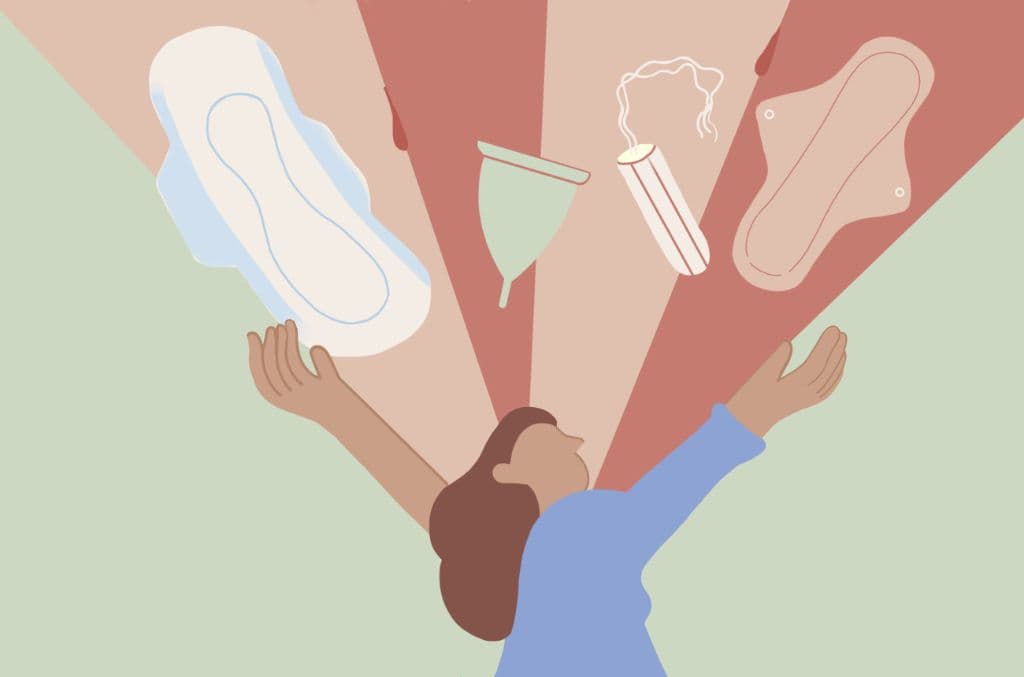How do I manage my period?
My introduction to menstruation was in a “sex education” session conducted by a big sanitary napkin brand in school. The session was for all the girls in standard eight, and as it turned out, had nothing to do with sex. Soon after, I got my first period. The only way known to us for managing periods then was to use a sanitary napkin. The sanitary napkin packet at the pharmacy would be covered in a newspaper. Then, that newspaper would go into a black polythene bag to facilitate its secret journey from the pharmacy back home. Once it reaches its destination, it would be carefully hidden within layers of clothing and taken to the bathroom. At school, it would be hidden in a designated secret pocket of the school bag and once again, secretly taken to the washroom in our pockets. It wasn’t something anybody should (read: could) see.
Where is my vagina?
Let’s look at my college days. Going to a girls’ college and living and staying in an affiliated hostel in Delhi - menstruation wasn’t a secret anymore. I would carry it as if it were my phone. It was normal. When I was 18, my roommate introduced me to tampons. I had never seen an advertisement for it before. I didn’t even know what it looked like, really! The only references were some Hollywood films, where women used tampons instead of sanitary pads. It took some time to get used to the idea of insertion, the fact that you can manage your periods in a whole new way came as a surprise to me. I remember having a sit-down with my friend, who told me how exactly it needs to be done. The first thing that came out of my mouth was “…but how do I locate the right hole?”. Unlike in the West, tampons did not come with an applicator, so all the work was left to my fingers. When I got my period, I simply went to my room, shut the door, located where I thought my vagina should be and inserted the tampon as I was told.
That was it, I thought. My work here was done but the whole time I attended classes that day, I feared if I pulled it out, the string would break and the tampon would just stay inside. My experience with gynaecologists (until then) had been absurd and painful enough that I didn’t want to make another trip in case something goes wrong. Ultimately, I underestimated the strength of the string, and the tampon came out like it was supposed to. My relationship with my periods changed (for the first time). I would now not have to worry about rashes, the uneasiness of wearing a sanitary pad and most of all, I could finally enjoy swimming anytime I wanted.
Read our blog: 5 Questions to Ask Your Gynaecologist If You Haven’t Already

How does my period affect others?
When I embraced tampons, I thought it couldn’t get any better than this. But then, as I turned 21, I started working for an organization that advocated sustainable menstruation. Through my work, I was introduced to the effects of menstrual products on our environment and different communities. Just the sheer amount of waste they produced, our inability to dispose of them properly and how hazardous they were to safai karamcharis. The choices I was left with were switching to a menstrual cup or/and cloth pads. Due to lack of information and guidance, I put the idea of using the cup on halt and gave cloth pads a try.
I then used tampons and cloth pads in combination. While travelling, I would use tampons only, perhaps because of convenience. I found it hard to wash and dry the pads while I wasn’t home. Another thing that I found a little difficult with pads was drying them. It wasn’t so much about what people would say (though that did cross my mind every now and then) but more about not finding adequate sunlight to dry them in. However, I found cloth pads extremely comfortable, which was unexpected to me. There were no rashes even though I was always told otherwise, as if using cloth was something primitive. In my opinion, it is actually one of the best alternatives. It is different from using a tampon or a pad though. You cannot simply wear it, take it off and throw it away. Instead, you wear it, you take it off and then you wash it. You take care of it. You wash it with your hands, you let the blood flow through your fingers. I feel there is something very raw and beautiful about it. It puts your relation with your menstrual discharge in perspective. I remember the days when I would use a sanitary napkin and every time the stench would always throw me off. Using cloth pads and touching my own blood was never revolting, this again changed my relationship with my periods (the second time).
Even though I partially switched to cloth pads, the idea of using a menstrual cup was always in the back of my mind. At 22, I began working with an organisation that worked on awareness about menstrual cups. To be honest, I was just excited to use one; and it seemed like the perfect solution to both convenience and being responsible. Despite the excitement, the first time I wore the cup, I was anxious. I remember coming back to my room and sharing with my friend how I was afraid that it would never come out. I knew it couldn’t get lost but this time, there was no string. It was all up to me: how patient I could be, if and how I could relax my muscles, if my fingers could reach the tip and squeeze it enough to break the suction. My friend assured me that the worst that could happen is a trip to the gynecologist (thankfully by this time I had found a good and an impartial one). I went for my scheduled lecture and when it was time, I managed to take the cup out rather easily. I was pleased with myself; the process that I thought would be nightmarish was actually very simple. Though it was completely smooth and took me a few cycles to get used to and do it more efficiently.
Now, instead of being spread on a cloth pad or soaked by a tampon, I could look at my blood as it was while changing the cup. I tried to do a couple of things with it, several times I poured it in soil. As a part of my work with the organisation I also shot my blood to be a part of the film we were making. I also once painted with it. I painted with my own menstrual discharge, the discharge that I was told was dirty, and the discharge that made me impure. I think this marked a whole new shift of my relationship with my period (for the third time and hopefully not the last).
Every new step in my menstrual journey only brought me closer to my menstruation, to my vagina and to my body. It started as something that was external and had to be kept in layers, always hidden. It then became about being more aware of my body. Finally, it was about being closer to my menstrual process while being more responsible and more ethical about how I chose to manage a process within my body to processes that are external.
I am 25 now and I have a jar of blood that I stored in my fridge yesterday.
I think I am going to go paint.
Disclaimer : This information is educational and should not be construed as medical advice. Please consult your doctor before making any dietary changes or adding supplements.
ProactiveForHer is a digital clinic for women, offering accessible, personalised, and confidential healthcare solutions. We offer out-patient care, diagnostic services and programs for various health concerns of Indian women, across their lifetime - from puberty to pregnancy to menopause. To know more on the sexual and reproductive health of women, visit https://www.proactiveforher.com/

